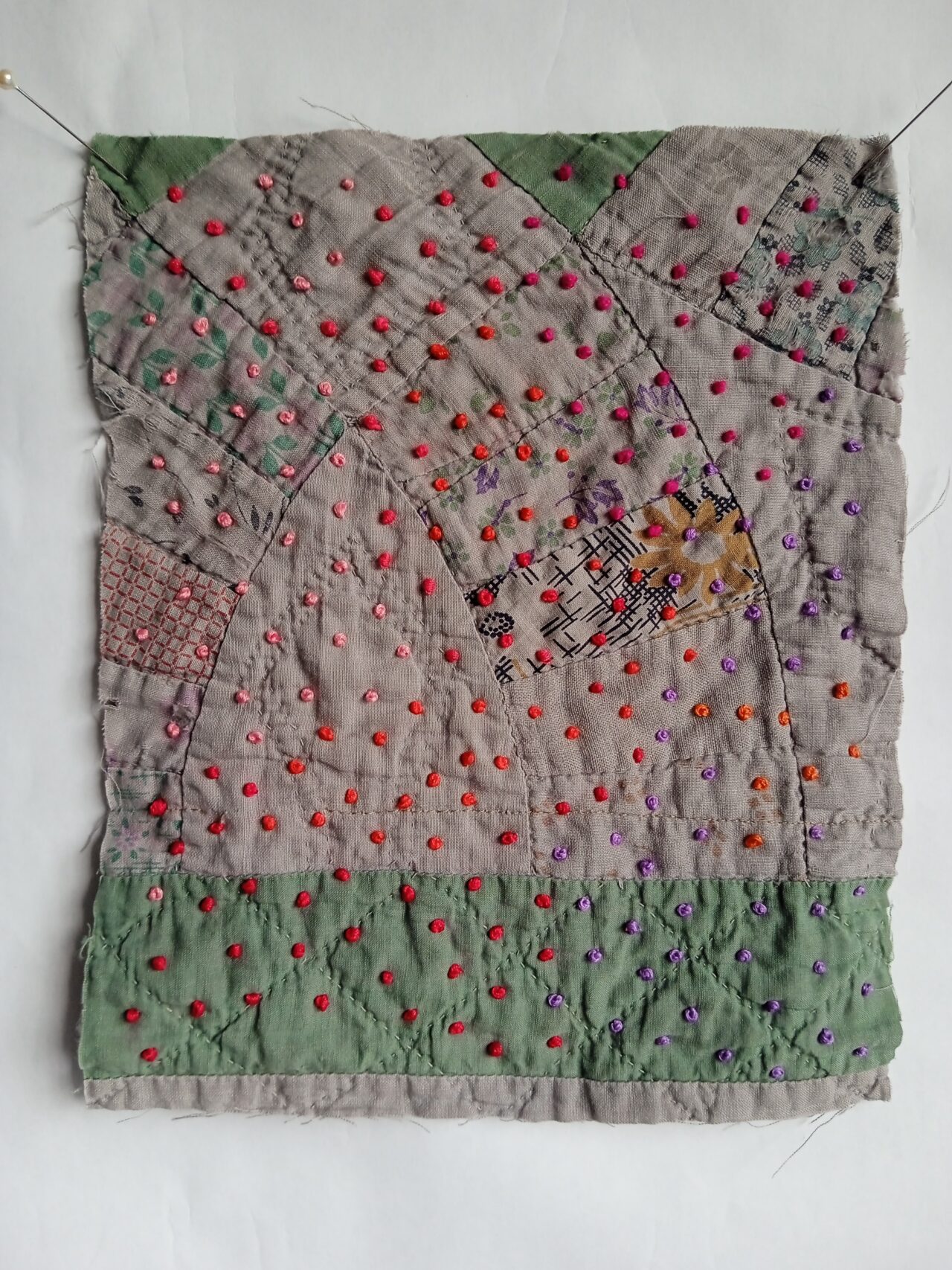Heather Young Crafts Atmospheric Patchwork Canopy for Bard on the Beach’s ‘Henry V’

Designer and educator Heather Young helped lead a team of set designers to create a textile installation for Bard on the Beach. (Image courtesy Amir Ofek / Heather Young)
Posted on
The designer and educator worked for months with set designer Amir Ofek and his team to source, stitch and hang the immersive textile installation.
A textile installation created by designer and ECU faculty member Heather Young helped conjure a moody atmosphere for this summer’s production of Shakespeare’s Henry V at Bard on the Beach.
Heather, who has worked summers in the Bard costume department for years, led the production of the massive textiles for the unusual staging of the famous play.
“This year, they were looking for someone to take on the job of a textile installation and work with set design,” she tells me. “I said, ‘Yes, I can do this,’ but really had no idea what I was saying yes to. Which was terrifying but exciting at the same time. I came to the realization that I could do large-scale textile and I learned that it’s okay to jump in and be scared.”
Henry V represents Bard’s first fully immersive 360-degree set. The textiles that envelop the performance space and draw the audience toward the action were the brainchild of Bard set designer Amir Ofek. Amir envisioned a backdrop that would strip the scene of “any time, any place.” But this vision would take him outside familiar territory, he tells Stir. Realizing he was interested more in a fabric sculpture than a typical set, he asked Heather to help lead the way.

“I was thinking of industrial fabrics, maybe loose-weave, natural,” Heather says of the search that led her to a familiar source for the Henry V textile installation. (Photo courtesy Amir Ofek / Heather Young)
Heather assembled a range of sample fabrics and materials for Amir. One such sample came from a familiar source.
“I was thinking of industrial fabrics, maybe loose-weave, natural. And then I remembered JJ Bean had given our housing co-op some coffee-bean bags,” she says. “I contacted them just to see what they’d say, and they were happy to give them away. They said, ‘We have hundreds of them. If you want to pick them up, we’ll give them to you.’”
Amir loved the burlap, and Heather got to work. With a team of set designers, Heather spent months collecting, deconstructing and performing “breakdown” on the burlap sacks. This involved laying them out on the ground, weathering them and adding rough applications of paint to artificially age the fabric.
After that, the stitching began. Heather herself sewed roughly 20 per cent of the material on an industrial machine. The remaining 80 per cent was sent to a shop that sews for film. In total, more than 400 bags were used for the set, along with 50 metres of raw burlap fabric.

With a team of set designers, Heather spent months collecting, deconstructing and performing “breakdown” on the burlap sacks in the outdoor area of the Scene Shop at UBC. (Image courtesy Heather Young)
Once the needlework was complete, Amir, Heather spent a week collaborating with riggers to hang the panels in place. Heather admits to some nerves as she waited to see whether her weeks of work were based on correct measurements. But the team kept a sewing machine on site for last-minute alterations which, happily, were minor. And at the end of that week, Heather found herself standing in a billowing patchwork pavilion.
“It was wild,” she says. “All of a sudden you were inside a tent. It reminded me of when you’re a kid and you make forts in your living room out of sheets and blankets. That’s what it felt like.”
Heather did her Master’s degree in fashion design and textiles and ran beloved Vancouver fashion label Dust for a decade. While she now teaches fashion at Kwantlen Polytechnic University, she’s also the founder of The Craft Lab, which offers workshops to encourage community-building around traditional and experimental textile practices. Her interest in foundational practices such as natural dyeing, and foraging and growing plants animates her work as an educator in the Industrial Design program at Emily Carr. These interests are also part of why she finds working in theatre so satisfying.

Heather's interest in reclaimed textiles animates her personal practice as well. Textile Wanderings (pictured above) uses a dye called Cochineal (a millenia-old colouring agent made from cactus-eating insects and iron) and French knots to alter an old, hand-stitched quilt passed on to Heather from an auntie. (Photo courtesy Heather Young)
“I feel like really ancient textile skills are being kept alive in theatre,” she says. “And it’s just a super creative place where people are open to non-traditional or non-linear creative processes. Even the people at the top who are in charge of the whole thing understand that. It’s a looser process and very collaborative. And there are always new challenges.”
But perhaps the best part is being able to attend the show as a member of the audience. This year, Heather attended both opening and closing night.
“Theatre is incredible. It’s ephemeral and it’s experiential. I never thought of myself as a theatre person, but it really is transformative. You are in a different world for an hour and a half,” she says, adding that seeing her team’s immersive environment brought to life in Henry V made for a particularly satisfying moment.
“It was amazing. I loved it. It was magical.”
Follow The Craft Lab on Instagram and visit them online to find out more about Heather’s work.
Visit the ECU website to learn about studying Industrial Design at Emily Carr.